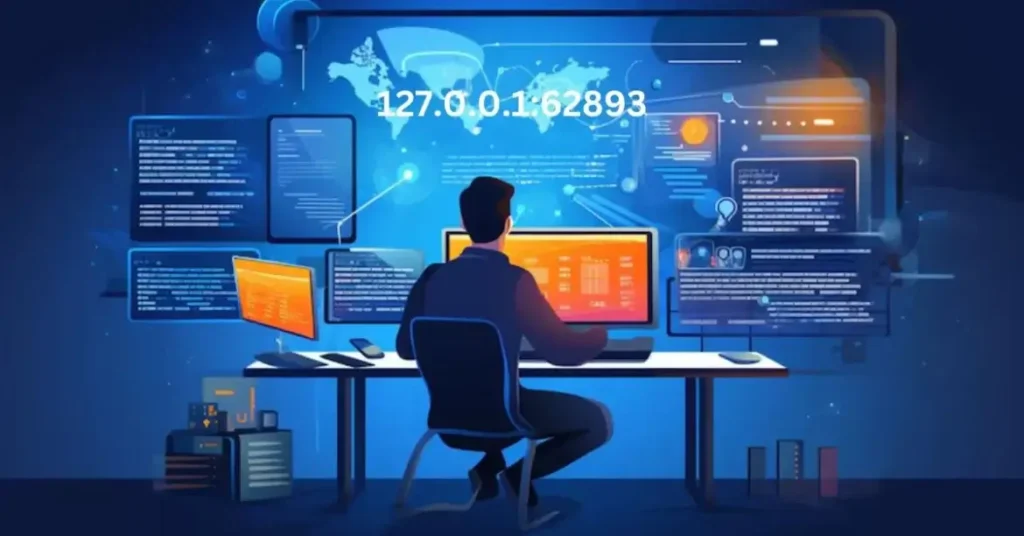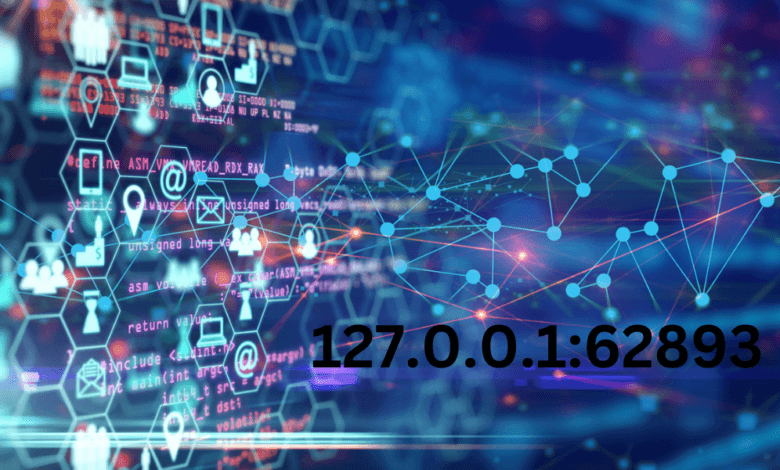127.0.0.1:62893 Meaning, Error, and Fixing Common Tips

Introduction
In the world of networking and web development, the address 127.0.0.1:62893 often appears, leading many to wonder what it really means and why it is significant. This address combines the well-known IP 127.0.0.1, also called localhost, with a specific port number, 62893.
We will dive deep into the meaning of this combination, common errors associated with it, and how to fix those errors. Whether you’re a beginner trying to troubleshoot a local server issue or a seasoned developer working on networking configurations, this article will provide valuable insights.
Understanding 127.0.0.1
What is 127.0.0.1?
127.0.0.1 is known as the loopback address or localhost in networking. It’s a special IP address that is used by a computer to communicate with itself. This allows software to establish network connections even without having an external connection. It is primarily used for testing and development purposes.
How the Localhost IP Works
When an application connects to 127.0.0.1, it is essentially talking to the same machine that it’s running on. This is handy for developers who need to simulate server behavior without accessing external networks. For example, web developers use it to test websites on their local machine before making them public.
Common Usage of Localhost
The most common use of localhost, especially with 127.0.0.1, is in web development environments. It allows developers to test websites, APIs, databases, and other services locally, without relying on external servers. It’s also useful for diagnosing network issues since it doesn’t require an internet connection.
What is Port 62893?
Definition of Ports in Networking
In networking, ports are like virtual gateways that direct traffic to specific services or applications running on a machine. Every service or application that communicates over a network does so via a unique port number. There are 65,535 ports available for use, with each one assigned to specific services, such as web servers, databases, or other programs.
The Role of Port 62893
Port 62893 is not reserved for any well-known service by default. It’s typically used by custom or user-specific applications that need to communicate via localhost. When paired with 127.0.0.1, it designates a specific communication channel for services running on the local machine.
Common Services Running on Port 62893
While no default services are tied to this port, it can be used by web servers, custom applications, or development tools running on your machine. Port 62893 might also be used by software or scripts that require local networking.
127.0.0.1:62893 – What Does it Mean?
The Connection Between IP and Port
When you see 127.0.0.1:62893, it refers to a service running on your machine that’s accessed through port 62893 on the localhost IP 127.0.0.1. This address allows you to connect to the specific application or service assigned to that port locally.
Why is Port 62893 Linked to Localhost?
Ports like 62893 are used to differentiate between multiple services that could be running on 127.0.0.1. While the IP is always the same, the port number specifies which service you’re trying to reach. This flexibility allows different services to coexist on the same machine without conflict.
Potential Applications of 127.0.0.1:62893
Developers often use this setup for running local servers, databases, or other tools that need to interact with software on the same machine. For example, you might use 127.0.0.1:62893 to host a web server on your local machine for testing purposes.
Common Errors with 127.0.0.1:62893
Understanding the Errors
Working with localhost and custom ports can sometimes lead to frustrating errors. Let’s take a look at the most common ones associated with 127.0.0.1:62893.
Connection Refused Error
This error occurs when an application tries to connect to 127.0.0.1:62893, but no service is running on that port. It usually means that the service has not started or there is a misconfiguration.
Time-Out Issues
A time-out error happens when the connection takes too long to respond, indicating that either the service is overwhelmed, or there are network problems on your machine.

Network Socket Errors
A socket error occurs when there’s an issue with the underlying network communication between the application and 127.0.0.1. This can be due to firewall restrictions, misconfigured ports, or other networking issues.
Causes of Errors with 127.0.0.1:62893
Misconfiguration of Localhost
One of the main causes of errors is incorrect configuration of the localhost. If your machine’s network settings are not properly configured, services running on 127.0.0.1 might not be accessible.
Firewall or Security Settings
Firewalls can block communication between your applications and 127.0.0.1. Even though it’s a local connection, security settings might prevent access to certain ports.
Port Conflicts
If multiple services attempt to use the same port, you’ll encounter port conflict errors. This can prevent applications from starting or cause unexpected behavior when accessing 127.0.0.1:62893.
Fixing Errors Related to 127.0.0.1:62893
Restarting Services
Sometimes the easiest fix is to simply restart the service that’s using 127.0.0.1:62893. If the service is frozen or crashed, a restart can resolve the issue.
Configuring Ports Correctly
Make sure that the application you’re running is set to use the correct port number. Check configuration files or command-line arguments to ensure port 62893 is assigned properly.
Allowing Ports Through Firewalls
Update your firewall rules to allow traffic through port 62893. This is especially important for applications that need to communicate with other software on the same machine.
Using Command Line for Troubleshooting
Command-line tools like netstat or lsof can be used to diagnose whether the port is being used and by which service. This can help identify port conflicts or inactive services.
Advanced Troubleshooting Techniques
Checking System Logs
System logs often contain valuable information when diagnosing localhost issues. Logs may point to configuration problems or errors related to 127.0.0.1:62893.
Analyzing Traffic with Network Tools
Tools like Wireshark can be used to monitor traffic on port 62893. This can help identify any unusual activity or misconfigurations.
Verifying Port Usage
Use tools like netstat to ensure that port 62893 is actively being used by the correct service. This prevents conflicts and helps track down errors.
Preventing Future Issues
Properly Configuring Ports
Always double-check port configurations in your development environments. Misconfigurations are one of the leading causes of localhost errors.
Regular Maintenance of Localhost Setup
Regularly maintaining your machine’s network settings can prevent future issues with 127.0.0.1 and custom ports.
Monitoring Traffic and Security Settings
Monitor traffic on localhost to ensure that there are no unauthorized services using 127.0.0.1:62893. Regularly update security settings and firewall configurations.

The Role of Firewalls and Security in 127.0.0.1:62893 Errors
How Firewalls Affect Localhost Ports
Firewalls play a crucial role in determining whether or not your applications can communicate via 127.0.0.1. If a firewall blocks port 62893, you won’t be able to access the service running on that port.
Adjusting Security Settings for Better Performance
To fix errors, you may need to adjust firewall rules or security settings, allowing access to localhost ports while keeping your machine secure.
Balancing Security and Accessibility
Balancing security and accessibility is key. While you want to keep your machine secure, allowing local traffic on specific ports like 62893 ensures that your applications can run smoothly.
Tools for Debugging 127.0.0.1:62893 Errors
Netstat
Use Netstat to check open ports and identify which services are using 62893. It’s a quick way to find port conflicts.
Wireshark
For more advanced network troubleshooting, Wireshark lets you capture and analyze traffic, helping diagnose localhost issues.
Telnet and Curl for Localhost Testing
Telnet and Curl are useful command-line tools for testing connectivity to 127.0.0.1. They allow you to verify if a specific port is open and responding correctly.
Understanding Loopback Address in Depth
Loopback in Networking Context
The loopback address, 127.0.0.1, is a critical part of how networks function internally. It is essential for testing and development, allowing a machine to communicate with itself.
Why 127.0.0.1 is Special
While 127.0.0.1 is a reserved address for loopback purposes, its uniqueness lies in its role as a self-referencing IP address, making it essential in troubleshooting and development environments.
How It Relates to Local Development
For local development, 127.0.0.1 serves as a testing ground for developers before they deploy applications to public servers. It ensures that code runs properly in a controlled environment.
127.0.0.1 vs Other IP Addresses
Differences Between 127.0.0.1 and Public IPs
While 127.0.0.1 is local and only works within the same machine, public IPs are externally facing and used to connect to devices over the internet.
Using Loopback vs LAN IPs in Development
In development, 127.0.0.1 is preferred for local testing, whereas LAN IPs are used when testing on internal networks that involve multiple machines.
Why Port Conflicts Occur
The Role of Ports in Networking
Ports are vital to directing network traffic. Without proper port management, you risk conflicts where multiple services try to use the same port.
How to Detect and Avoid Port Conflicts
Using network tools, you can detect which services are using specific ports. To avoid conflicts, always assign unique ports to each service or use dynamic port assignments.
Conclusion
Understanding the combination of 127.0.0.1:62893 and its associated errors can make troubleshooting local development environments much smoother. By recognizing how localhost and ports work together, you can effectively address common issues and keep your machine running efficiently. Regular maintenance and monitoring of your machine’s networking setup will help you avoid future conflicts and errors.
FAQs
- What is 127.0.0.1:62893 used for?
It represents a service running on your local machine, accessed through port 62893. - Why am I getting a “connection refused” error?
This usually happens when the service you are trying to access is not running or is misconfigured. - How do I check if port 62893 is open?
You can use tools likenetstatorlsofto check which ports are open and what services are using them. - Can a firewall block localhost connections?
Yes, firewalls can block specific ports even on localhost. Ensure that port 62893 is allowed through your firewall. - What causes port conflicts?
Port conflicts happen when multiple services attempt to use the same port. Using unique port numbers for each service can prevent this.



